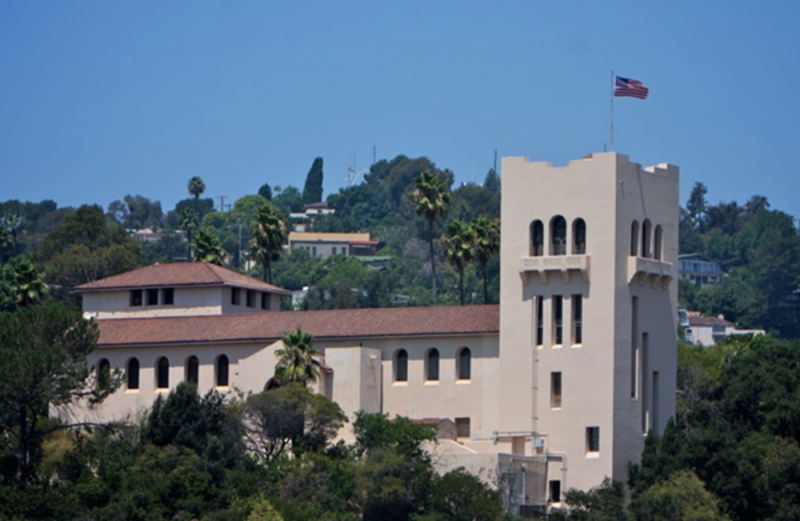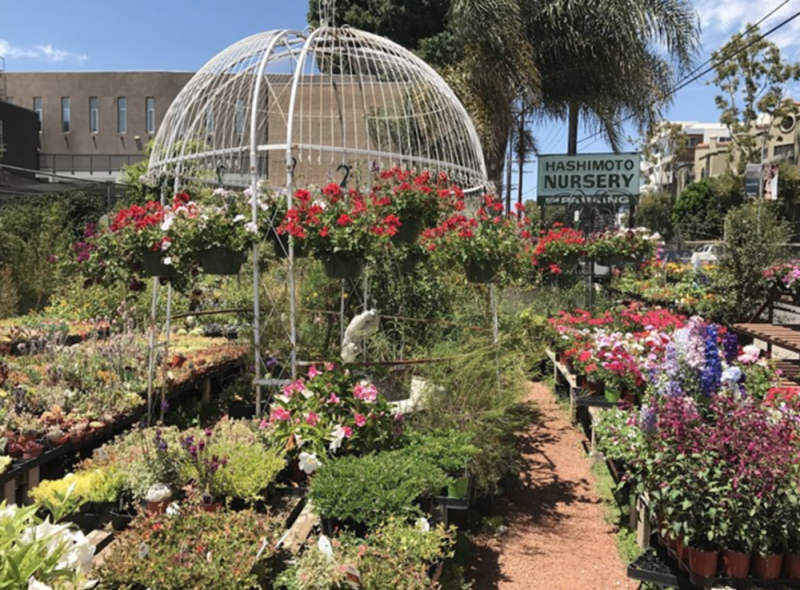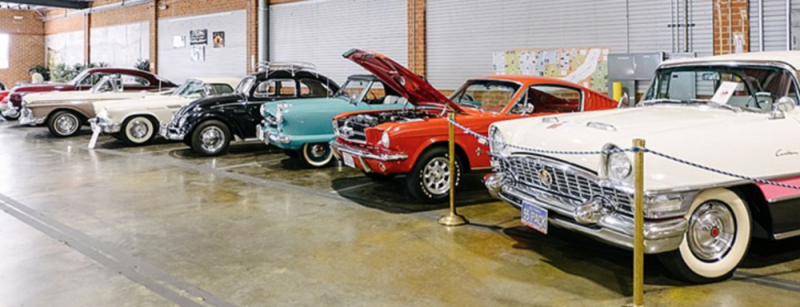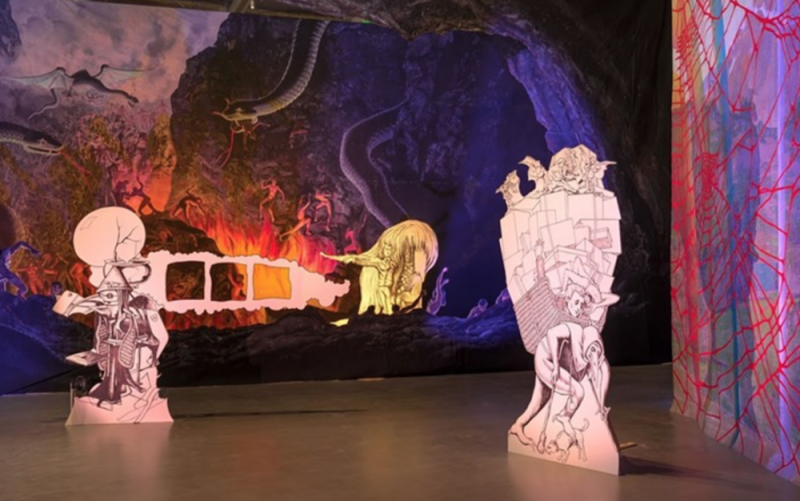Danny Liao
Best Offbeat Adventures for L.A. History Buffs
LA WEEKLY | NOVEMBER 8, 2017 | 5:37AM | Danny Liao
Who says Los Angeles doesn’t have any history? It’s an oft-cited adage that L.A.’s seemingly youngish age —FYI, we’re much older than we look — makes it inferior to those archaic metropolises perched on America’s other coast. But for Angeleno insiders, we know that our city’s roots run deep. In our 2017 Best of L.A. issue, we showcase the city’s top hot spots, but we also reveal some exciting places where Los Angeles history comes alive. Whether you’re checking out architectural treasures or taking a spin in a classic L.A. ride, these places offer an unmissable chance to educate your mind, make a new discovery or simply inspire a sense of wonder.
Most Haunted House: John Sowden House
Inspired by the ancient Mayan city of Palenque (as imagined by an erstwhile movie set designer for Paramount), the fortresslike Sowden House was built for the lavish parties of silent film–era Hollywood. Architect Frank Lloyd Wright Jr. — or Lloyd Wright, as he was known — built the faux-Mayan temple to physically imposing scale on a hill in Los Feliz (the awe-inspiring patterned block cantilevers that project from the roofline above the entrance have been likened to the jaws of a great white shark). Inside the house has an Eleusinian feel: Twisting passageways, dark recesses and secret rooms flow into an atrium with undulating contours of stonework and a proscenium stage. The overall effect is what one architecture historian has called a “unique but indeterminate exoticism.” This is not a house so much as a showcase, an open space for a select group to enjoy in privacy and seclusion. The real notoriety of the house dates from 1945, when George Hodell, a sybaritic physician and friend to surrealists and Hollywood A-listers, bought the property and redecorated (all-red kitchen, all-gold master bedroom) to host infamous sex parties “delving into the mystery of love and the universe,” as he told Los Angeles police detectives investigating a rape charge brought against him by his 14-year-old daughter after one such party (Hodell was acquitted of rape and incest in 1949 and sold the house soon thereafter.) Many years later it was revealed that the LAPD considered Hodell the prime suspect in the Black Dahlia murder. He may even have killed and dismembered the starlet in a locked room in the basement. The house will be hosting art events by invitation this fall. — Jason McGahan
5121 Franklin Ave., Los Feliz; (202) 460-4006, sowdenhouse.com.
Best Little History Museum in the Valley: Valley Relics Museum
You don’t need to be a relic of the San Fernando Valley to appreciate the Valley Relics Museum, but it helps. Founded by SFV native Tommy Gelinas, this lovingly curated reservoir of ephemera features a collection belonging to Bob and Julie Ream, longtime Valley residents who worked in the two industries that transformed the Valley into the suburban boomtown it became: aeronautics and entertainment. One smaller exhibit honors cowboy tailor Nudie Cohn, but for those of us who grew up in the high-temperature Valley during its hazy heyday of the ’70s and ’80s, the bitchin’ wave of nostalgia swells inside the museum’s main room. Here, the nondescript industrial warehouse space is transformed into an immersive time machine, stockpiled with old neon signs, retired mascots, local sports memorabilia, vintage BMX bikes, weird cars and neighborhood restaurant menus from an era when one could comfortably puff on a cigarette between bites of a $2.95 chicken dinner at Love’s Wood Pit Barbecue. The one thing missing is a ride simulation with animatronic parents dropping off their kids at Topanga Plaza, only to have them cross the street and spend their food money at Licorice Pizza (or, better yet, Moby Disc). — Tanja Laden

21630 Marilla St., Chatsworth; valleyrelics.org.
Courtesy Autry Museum
Best Museum That’s Also a Designated National Treasure: Southwest Museum of the American Indian
Journalist Charles Lummis served as the city librarian of Los Angeles for a few years in the early 20th century and throughout his life was a champion of Native American issues and preserving Southwest history. Those passions converged when he founded the Southwest Museum of the American Indian in 1907. Its castlelike Mount Washington building, designed by Sumner P. Hunt and Silas R. Burns, opened in 1914 and helped establish museum culture in the city with its vast collection of Native American artifacts. By the end of the century, the museum had fallen on hard times, including financial woes and damage from the 1994 Northridge earthquake. In 2003 it merged with the larger Autry Museum of the American West, which restored the building to its former glory (so much so that it was declared a “National Treasure” by the National Trust for Historic Preservation in 2015) and is working to repair more than 150,000 artifacts that were damaged in the quake. For now, the building houses a small collection of Pueblo pottery and an ethnobotanical garden with a great view. Admission is free, but the museum is open only on Saturdays. — Liz Ohanesian
234 Museum Dr., Mount Washington; (323) 221-2164, theautry.org.
Best Pocket Observatory: San Fernando Solar Observatory
When the San Fernando Solar Observatory — one of the oldest of its kind — was finally moved to Cal State Northridge in 2016, it enlivened an already charming corner of the campus. The dollhouse-like domed structure sits next to a landscaped turtle-and-duck pond and historic orange grove, with a campus lunch bistro and Bianchi Planetarium (which hosts night-sky shows every other Friday) within spitting distance. The observatory previously was used for research in support of NASA’s manned space and Skylab programs, but in its current iteration generates critical information on the sun and its effects on climate, satellites and spacecraft. The young astronomers plying the telescopes and computer systems within are literally on the front lines of combating climate change, which gives it the observatory importance beyond its visual scale. To visit, use parking lot G3 off Prairie and Zelzah, but you can usually nab street parking on Nordhoff. Non-students should contact the school’s department of physics and astronomy for access. — Suzy Beal
18111 Nordhoff St., Northridge.

Drew Tewksbury
Best Historic Japanese Nursery: Hashimoto Nursery
Despite what idyllic postcards will lead you to believe, West L.A. is mostly populated by slabs of concrete, endless forests of stucco apartments and grimy strip malls. But there’s an oasis of green waiting amid this postwar suburban sprawl. Hashimoto Nursery, in the heart of Sawtelle Japantown, is burgeoning with begonias, hearty succulents and vast varieties of vegetation. A stroll through its expansive campus is a peaceful experience that will make you forget the hellish honking of the nearby 405 freeway. It’s also a walk back in time. The four Hashimoto brothers first settled in this Westside Japanese enclave around 1928 and opened their nursery a few years later. When World War II erupted, two of the brothers were sent back to Japan while the others were interned at Manzanar. When they were released, they opened the Hashimoto Brothers Nursery. The shop has been in operation ever since, providing diverse garden supplies with a sense of history. — Drew Tewksbury
1935 Sawtelle Blvd, West Los Angeles.

Danny Liao
Best Place to Go for a Classic Ride: The Automobile Driving Museum
The Automobile Driving Museum is a jewel hidden amid the corporate parks and industrial spaces of El Segundo. Inside this warehouse-like venue, you’ll find vintage and classic cars lovingly preserved. The museum’s old-school rides go way back — you might find some early Packards here — but also include mid–20th century favorites. The collection has wheels once owned by noteworthy folks such as Howard Hughes and Eleanor Roosevelt. Looking around the showroom is a visual treat, as it’s filled with shiny, sparkling vehicles that you rarely see out on the streets: a 1963 Studebaker Avanti, a 1959 Austin Healey, a 1982 DeLorean. But what’s more exciting is that you can ride in some of the cars yourself. On Sundays, a rotating selection of wheels is available to hit the streets with you in the passenger seat. You may not know what car you’ll get — recent rides included a ’39 Oldsmobile and a ’61 Corvair — but it’s certain to be in the most stylish car cruising the neighborhood. — Liz Ohanesian
610 Lairport St., El Segundo; (310) 909-0950, automobiledrivingmuseum.org.
Best Place to Gamble and Get a History Lesson at the Same Time: Looff’s Lite-A-Line
Part casino, part Long Beach history museum, Looff’s Lite-A-Line is named for the family that made the city into a reveler’s shoreline destination way back in the early 1900s. When you walk in, you must get your photo taken for a little card you can refill with money to play the games. Unlike most casinos with blackjack tables, slots and roulette, this one solely carries a pinball-like game of skill, where you must shoot little silver balls into holes, kind of like a Plinko-meets–Connect Four thing, with bingo elements — don’t worry, they’ll show you how to play. When your butt goes numb, try looking at the glass cases of memorabilia from the early days of Long Beach. There’s even an original Cyclone racer car from one of the old boardwalk coasters, along with a carousel horse, though don’t expect to ride either of them. Old historical photos show the bustling carnival the Long Beach shoreline once was, which is truly incredible, especially when you know it was all started by one adventurous family. Looff’s Lite-A-Line is all that’s left to carry on that legacy, and it’s a lot of fun. — April Wolfe
2500 Long Beach Blvd, Long Beach; (562) 436-2978, looffs.com.

Robert Wedemeyer
Best Place to Peek Behind the Illuminati Curtain: The Marciano Art Foundation
L.A.’s newest private museum, the Marciano Art Foundation, houses the art collection of the Marciano brothers, founders of the GUESS? fashion label. In addition to seminal works of contemporary art by the likes of Mike Kelley, Takashi Murakami and Jeff Koons, the Marciano offers a glimpse into the secret society of Freemasonry, which few of the uninitiated ever get to see. Tracing its origins back several centuries to European stonemason guilds, Freemasonry consists of fraternal orders whose ranks include captains of industry, almost a third of U.S. presidents and Hollywood bigwigs Walt Disney and Cecil B. DeMille, among others. The museum is housed in the former Scottish Rite Masonic Temple, a gleaming marble and travertine citadel designed by Millard Sheets in 1961, which has been thoughtfully repurposed by architect Kulapat Yantrasast of wHY, retaining much of the original structure’s character. Lining the building’s Wilshire Boulevard façade, massive sculptures by Albert Stewart depict important figures from Masonic cosmology, such as Imhotep, architect of the Egyptian step pyramids, and Zerubbabel, the Biblical builder of the Second Temple. Masonic symbols such as the square and compass are featured throughout, central to the Masons’ conception of themselves as builders. In their lodges and temples, Masons would enact theatrical, costumed rituals utilizing hand-painted backdrops, several of which have been incorporated by artist Jim Shaw into his stunning solo exhibition, The Wig Museum(through Jan. 13), on the main level. Upstairs, the Relic Room houses even more wonders: robes, hats, books, membership logs and other Masonic ephemera, opening a window onto a secretive, in large part bygone world. — Matt Stromberg
4357 Wilshire Blvd, Mid-Wilshire; (424) 204-7555, marcianoartfoundation.org.
IF YOU LIKE THIS STORY, CONSIDER SIGNING UP FOR OUR EMAIL NEWSLETTERS.
SHOW ME HOW
Danny Liao
Best Place to Witness Pre-Revolutionary China Without Leaving L.A.: Velaslavasay Panorama
Before movies became our culture’s dominant form of mass entertainment, there was the panorama, which captivated audiences throughout the 19th century. Often depicting immersive landscapes or important events, the panorama is a floor-to-ceiling cylindrical painting placed in a round room, at the center of which stands the viewer. Three-dimensional props, lighting and sound elements heighten the illusion of surveying a far-off land or historical scene. Founded by artist Sara Velas in 2000, the Velaslavasay Panorama is a contemporary twist on these fanciful Victorian houses of wonder. Its first iteration was located in the Tswuun-Tswuun Rotunda in Hollywood, where The Panorama of the Valley of the Smokes depicted a 360-degree view of the Los Angeles area as it might have appeared two centuries ago. A few years later, the Panorama relocated to its current home in the Union Theatre Building and debuted a new tableau, Effulgence of the North, which portrayed an icy, arctic vista, complete with the sound of cracking glaciers and a light show emulating the aurora borealis. After more than a decade, Effulgence closed Sept. 10, with a new panorama set to open next spring. Titled Shengjing Panorama, it will feature a 90-foot-long painting made in collaboration with artists in China, capturing an early–20th century view of the northeastern Chinese city of Shenyang — and thereby offering a window into another place and time. — Matt Stromberg
1122 W. 24th St., West Adams; (213) 746-2166, panoramaonview.org.
(661) 977-1973
INFO@PLATINUMPROPORTABLES.COM
WWW.PLATINUMPROPORTABLES.COM
BOOK WITH THE BEST TO IMPRESS YOUR GUESTS!



